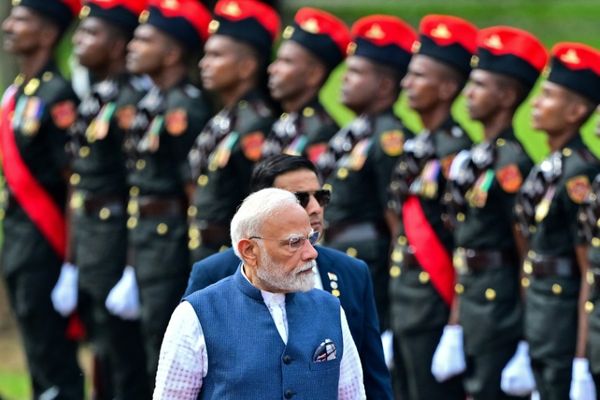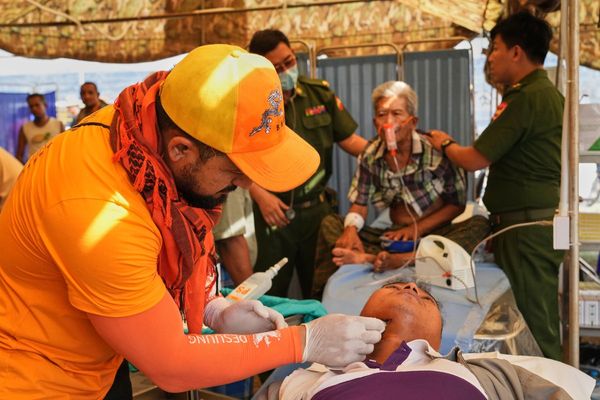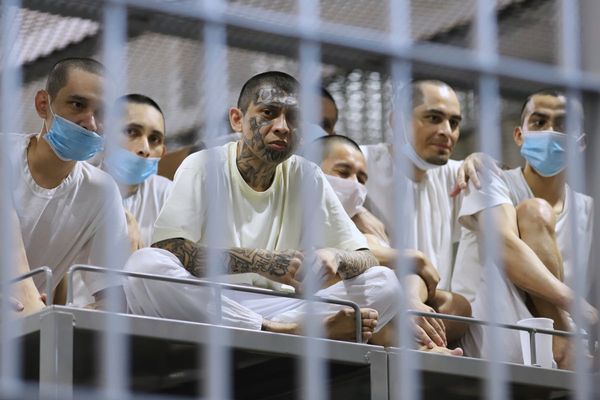
On a recent warm afternoon, a white, American-made SUV drove down the streets of the eastern Baghdad district of Sadr City. In the passenger seat sat an older militia boss, and behind him were two bodyguards, his five-year-old son, and a Kalashnikov. Their first stop was a small grocery shop, where a young man with a mop of ginger hair was busy serving customers.
One of the bodyguards beckoned to the young man, who came hurriedly and stood a respectful distance from the car. The militia boss stopped toying with his automatic pistol, pulled out a brown envelope from a large stash on the dashboard, and gave it to the young man, while one of the bodyguards handed him a small plastic bag from the back of the car.
“Go, my son,” said the boss in a husky voice. “This is your salary for this month, and a frozen chicken for your lunch.”
The young man accepted the largesse, bowed his head, and mumbled a few words of gratitude. A look of boredom flickered across the militiaman’s face, as he listened to a couple of old men who had gathered around the car, cheering, saluting, and calling upon Allah to bless the benefactor.
The car sped away, and the militia boss went back to toying with his gun. He told his bodyguards, who were stuffing money in more brown envelopes, that the young man’s father, who used to roam the streets selling sweets from a pushcart, was killed in 2015 when protesters tried to storm the Iraqi capital’s fortified Green Zone, which had been set up by the Americans after the invasion of 2003. “He is an orphan and he works in the shop to support his mother and sisters,” he said.
“May Allah curse all those people in the Green Zone,” replied one of the bodyguards.
Throughout the day, the car trudged through the crowded streets, sometimes driving down narrow alleys or across a flat dusty landscape dotted with concrete shacks, where children sifted through mounds of rubbish looking for plastic bottles and cans to resell. At one point the car drove along the bank of a 10-metre-wide canal flowing with green oily sewage. They made more than a dozen stops at houses that were no bigger than a small brick room with tiny holes for windows, some with corrugated metal sheets for roofs, and floors of bare earth.

At each stop the scene was repeated: the militia boss passed a brown envelope stuffed with cash, a bodyguard gave a frozen chicken, and cheers and calls for blessings came from the recipients, who were invariably either widowed women or orphaned children whose menfolk had died in the cycles of violence that have engulfed Iraq since the US-led invasion in 2003.
One elderly woman, after receiving her envelope and frozen chicken, complained to the militia boss that her four mentally unwell boys were beating her up. She pointed at a young man, who stood naked but for a loose shirt, chained to an electricity poll next to a grocery shop, and said she didn’t know what else to do. The young man stood humming to himself while passersby ignored him.
“Look around you – there is so much misery in this city,” said the militia boss. “Whatever I can do to help, I do, and with my own money, because no one is here to help those people.” He added: “People come to me constantly seeking aid, but we only give to widows and orphans who don’t receive a state pension.”
He said that he found the people who were really in need using the same spy network he had used to track his enemies during the brutal, sectarian civil war fought between 2004 and 2008 as the country fell apart. “We send our intelligence teams to investigate them and vouch for them.”
But that day, as he was making his rounds, he did make an exception. A shop owner pointed to a house and said the man who lived there, a tea seller, could barely walk and the family were very poor. One of the bodyguards went to the door and called on the father to come out. A few minutes later a frail barefoot man came out, dragging his right leg behind him, with his right arm visibly shaking. They gave him an envelope, and the boss told his men to add the family to their list.

A militia boss turned philanthropist
The militia boss was in his mid-50s, and walked with a dignified gait, making religious references as he spoke. Illness and two decades of war had left their mark: stooping shoulders, deep wrinkles around his eyes, and scars from multiple injuries. He wore a black tracksuit, with a black keffiyeh draped loosely over his bald head. His trimmed moustache and beard were dyed jet black. His men called him “Boya”, a diminutive of father in Arabic. “We were children when we first started to fight under his command,” said one.
Before he became a philanthropist concerned with the wellbeing of Sadr City’s poorest people, his name struck fear into the heart of Baghdadis, as he and his men had committed some of the worst atrocities during the civil war.
Before that, he was a special forces NCO in the Iraqi army. He described that period as “the age of ignorance” before he found the “right path” and became a disciple of the charismatic Shia cleric Muhammad Sadiq al-Sadr, whose sermons had channelled the anguish of the impoverished masses in Baghdad and the southern provinces during the years of sanctions between 1990 and 2003. The cleric’s charisma and popularity probably contributed to his assassination along with his two eldest sons in 1999.
Al Sadr’s youngest son, Moqtada al-Sadr, inherited not only his father’s network of clerics and his masses of devotees, but also his anti-American stance, which soon led to clashes between his followers – the Mahdi Army – and the Americans in the years after the US invasion. The militia boss now distributing frozen chickens was one of the hundreds who picked up arms and fought the Americans in the streets of Baghdad, Najaf and other Shia cities.

“We were poor and we fought with the scarcity of the weapons we had. People sold their furniture, their wives’ gold, to buy ammunition, but we had God and the banner of Imam Ali on our sides,” he said.
He told the driver of the SUV to take a detour and go down a wide two-lane thoroughfare, crowded on that afternoon with taxis, pickup trucks and motor-rickshaws. “This was our hunting ground,” he said. “We attacked the Americans every time they passed down this street. No one dared leave their house after sunset. Death was certain.
“Not everyone knew how to fight street battles, but I was in the special forces in Saddam’s army, and they used to drop us by helicopter into Kurdish villages to hunt for the guerrillas: the trick is to attack and withdraw.”
Of course in these glorious street battles, neither he and his men, nor the Americans, paid any attention to the civilians amid whom they were fighting. Twenty years later, some houses are still pockmarked with bullet holes.
The militia leader said his four eldest sons and his two brothers were captured by the Americans, but they never managed to get to him, because he never spent two nights in the same place and never owned a mobile phone. “These are spy devices invented by the Israelis to enslave us,” he said, pointing at a smartphone.
‘They killed people, we went after them’
By 2004 the war had shifted. Jihadis keen to start a civil war began targeting Shia neighbourhoods with car bombs, kidnapping and slaughtering Shia men. “Our fight became against two enemies, the Americans and the Takfiris,” he said, using a term for Sunni extremists.
And here is where the militia leader’s murderous reputation began spreading. Driven by a desire to avenge the killing of Shias, he and his men started raiding Sunni neighbourhoods, allegedly to kill “terrorists” but in reality kidnapping any men they found there.
Using ambulances, police trucks or black Opel sedans used by senior officials, they drove through police and army checkpoints unmolested. Sometimes their raids were conducted in coordination with the ministry of interior special forces, another infamous organisation that emerged during the civil war.
The militia chief’s name became a franchise for a multitude of gangs and militias that kidnapped, maimed and killed thousands. “They killed a lot of our people with their car bombs, but we went after them. I made the people of [the Baghdad neighbourhood] Adhamiya scared like chickens.”
He quickly rectified his comment, saying: “I swear by Allah we never killed in vain. We brought them here [to Sadr City], we interrogated them. And after they confessed to murder, a Shia cleric would issue us a fatwa. And only then would we execute them.”
Avenging the Shia became a lucrative business, he confessed, although he said it was “other commanders” who would extort ransom money for the “terrorists” they captured.
The bodies of those murdered by the Shia militia were dumped in mass graves, not far from where he was distributing aid that day.
As he spoke, his youngest son, squeezed between his father’s loyal bodyguards, fiddled with the barrel of a Kalashnikov taller than him.
The crowded streets of Sadr City
Sadr City has always been an overcrowded place, inhabited by poor people. The large working-class suburb that once sat on the eastern flanks of Baghdad is now an integrated part of the city after its urban expansion in recent decades. It was first devised in 1959, to house mostly peasants who had migrated from the south to escape the brutal feudal lords and lived in reed huts on the outskirts of Baghdad.
Originally named Thawra [Revolution] City, it was a hastily and cheaply constructed housing project, built on a grid pattern, and divided into sectors each containing 1,100 identical two-storey brick houses. In 1982 new residential blocks were added – along with eventually unsuccessful attempts to solve chronic sewage problems – and it was renamed Saddam City.
After the invasion it became the stronghold of Moqtada al-Sadr and his followers, and acquired its current name. But it’s most commonly known as al-Madia, The City. A place home to a large number of writers, musicians and artists – and a place where weapons are traded, documents are forged and military deserters have always found shelter.
In the 20 years since the invasion, its population has tripled. The crowded houses have been divided into smaller and smaller units, and Sadr City’s boundaries have expanded further to the east to accommodate waves of even poorer migrants from the south.

Even Sadr City is beyond the reach of some. Many newcomers have settled on parched agricultural lands on outskirts that have been bulldozed and parcelled into tiny plots of land. New suburbs of cinder-block hovels have risen in recent years, forming slums behind the slums. Cars slowly negotiate the dirt roads with their gaping potholes. Dogs roam in fields of rubbish, where children collect plastic bottles and cans and sell them for recycling. Jungles of electrical wires are rigged between houses, siphoning electricity for the city’s main grid, and raw sewage is discharged into open canals, from where cat-size rats swarm into homes. Drinking water is sold from plastic tanks slung from the back of motorcycle rickshaws. These are the territories where the militia boss distributes his charity.
Sajad is short and stocky and dressed in a cream-coloured dishdasha and a long checkered keffiyeh. Like most residents of this wretched neighbourhood, he came to the Iraqi capital from the impoverished southern province of Ammara.
“At least here in Baghdad, you can work three or four days a week as a porter in the market, a day labourer, or open a stall selling tomatoes and vegetables and make 10k dinars ($6) a day. In the south, there is nothing but hunger,” he said
He held out his hands towards the dirt lane in front of his small house: “Before each election, politicians come and promise to pave the roads, bring us electricity and running water, and then they disappear.”
A torn Iraqi flag fluttered from the neighbourhood school, “The Rising Dawn”. It was built in 2014, with prefabricated containers, but the roofs sagged and were covered in corrugated metal sheets and the walls are rusty and cracked. In the summer it is stifling hot, and in the winter it drips with rain, but because of a shortage of local schools it is attended by four shifts of students each day.
On a recent afternoon, dozens of girls filled the dirt lane outside the school, jostling between the dozens of TukTuks parked outside, their pink headscarves bobbing up and down, as another group of girls trudged in the opposite direction, heading to class.

“Although summer is very hot without electricity, it’s more merciful on us than winter,” Sajad said. “Because when it rains, the streets turn into swamps and sometimes schools close because the children sink up to their knees in mud.”
Farther to the east, beyond a small lake where tankers discharge the city’s sewage, where a carcass of a dead cow floated between plastic bottles and trash, lay an area known as Sadda, which means a dam in Arabic. Once part of the city’s flood defences along a river that has long since dried up, it became a dumping ground for Sunni victims of the civil war. Locals would bury their bodies under a thin layer of dirt, marking each grave with a piece of scrap metal or any other random object.
But what in 2009 was a mass grave is now a densely populated neighbourhood, as the city spread. “People often find bones and human skulls when they dig latrines,” said one local.
In the sectarian narrative of post-2003 Iraq, the Shia – who make up most of the population – were promised a place at the top of the new social order. Instead, for two decades, they became cannon fodder, while a small elite of politicians, warlords, militia commanders and their cronies have become billionaires. This deep social divide has allowed men like the militia boss to rebrand themselves as philanthropists.
“Don’t ask me why the state does not care for those people,” he said. “Ask me why the Shia clergy abandoned those people, why they invest in private hospitals, universities and factories – are those Shia more worthy of that wealth? Why do the ‘Big Turbans’ travel to London and Iran for medical help while these people – Shia like them – are living in these hovels?”

‘Here I am among my people’
At one point during the civil war, the militia boss – like Moqtada al-Sadr himself, and many other Shia commanders – fled to Iran. While he was there, he says, the Revolutionary Guards (IGRC) encouraged him to form his own militia, splitting from the Mahdi Army. He says he refused. “My loyalty was and always will remain to Moqtada, he is my leader. Only a whore would change her allegiance for money.”
A few years later, he returned to Iraq, and found a comfortable place for himself in the fat margins of the corrupt Iraqi state, benefiting from government contracts and other deals. Twenty years after the invasion that ignited a civil war and granted power to men like him, there has been no accountability for those who stoked the conflict or murdered civilians.
Many of his fellow commanders, who fought in the same streets, have since become political leaders, fielding candidates in parliamentary elections, and controlling economic empires that siphon billions of dollars from the state budget. Twenty years on, he is still essentially a local militia boss, a glorified neighbourhood thug.
“I am happy here in this neighbourhood,” he said. “I can go live anywhere in Baghdad, but here I am among my people, they are my true protection.”
As he finished making his payments, he told the driver to go into a sidestreet, not far from where he fought the Americans. The car turned into an alley, and entered a large yard. Inside were a dozen or so armoured pickup trucks that had once belonged to the Iraqi army.
“These are all mine – and I have men and a lot of ammunition, too,” he said. “I keep them ready in case I ever need to use them again.”
The Iraq invasion: 20 years on, with Ghaith Abdul-Ahad
Join Ghaith Abdul-Ahad who will be talking to Devika Bhat in a livestreamed event on his powerful new book: A Stranger In Your Own City on Monday 27 March 2023, 8pm–9pm BST. Book tickets at theguardian.com/guardianlive







